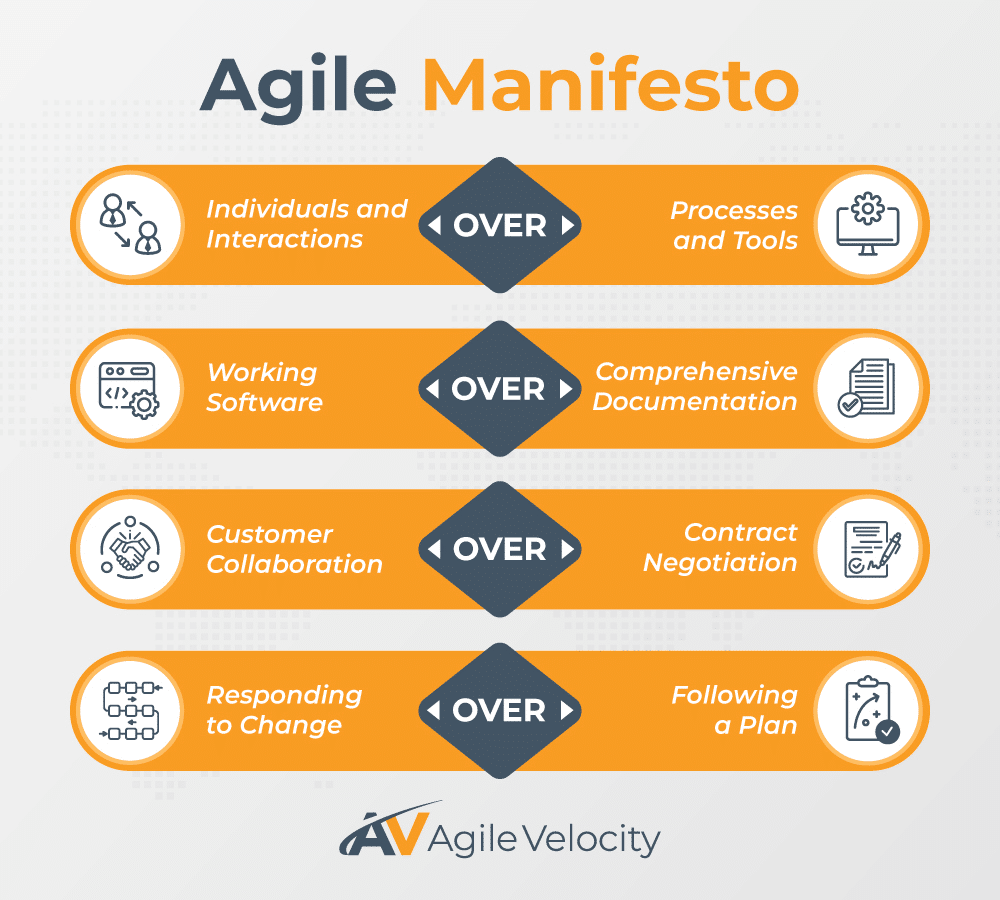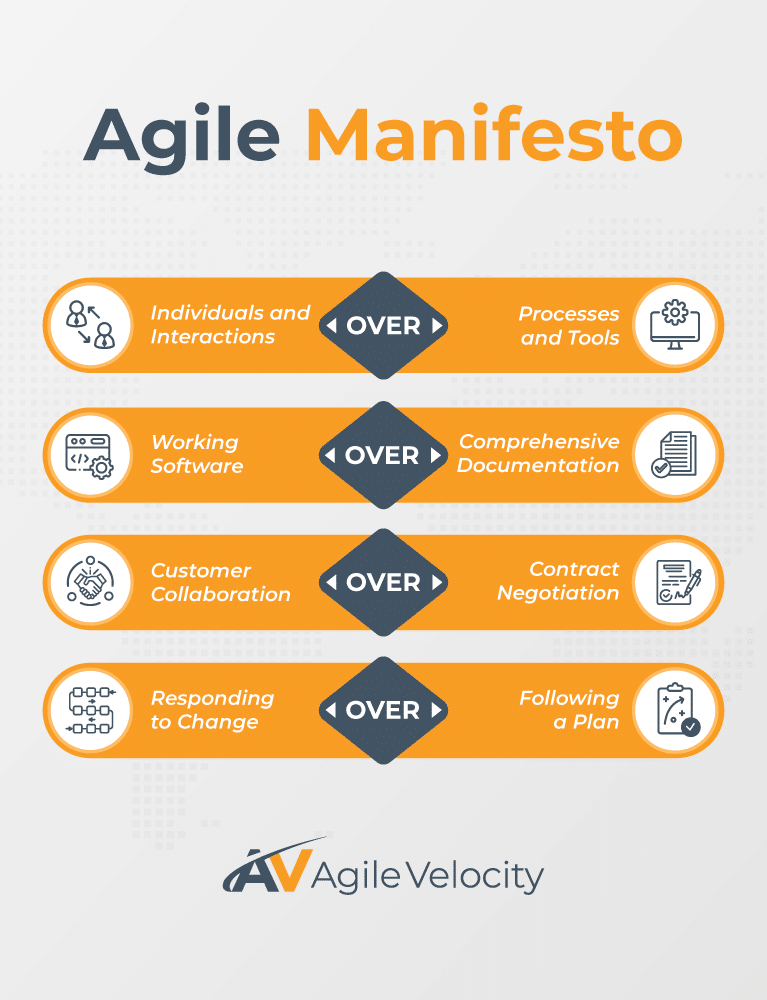Agile practices continue to are transform how modern organizations tackle planning, development, and delivery, driving meaningful changes for companies aiming to stay competitive. In fact, Agile practices are at the forefront of rethinking work in today’s environment. This shift, often referred to as an Agile Transformation, empowers teams to embrace a culture of adaptability, collaboration, and continuous learning. At the heart of this movement is the Agile Manifesto, the guiding compass for Agile practitioners worldwide. Its four core values form the foundation for fostering flexibility, innovation, and responsiveness—key traits for success in today’s dynamic, technology-driven landscape.
In this article, we’ll uncover the essence of the four core values of the Agile Manifesto and explain why they remain indispensable for organizations striving to build agility and deliver lasting value. From understanding how these values enhance collaboration and adaptability to examining practical ways to incorporate them into daily workflows, we’ll explore their wide-reaching impact. We’ll also touch on how Agile Velocity’s proven expertise can help teams and leaders bring these principles to life, creating lasting change. By the end, you’ll have a clear understanding of why these values are essential for navigating the evolving demands of the modern business world and how they can set your team up for success.
The Importance of the Four Agile Values in Organizational Agility
Understanding the significance of the four Agile values is essential for any organization striving to achieve organizational agility across its teams and processes. These values serve as the foundation for creating a culture that embraces adaptability, collaboration, and responsiveness—key elements that drive success in today’s fast-changing world. Without embracing these Agile principles, organizations may continue to rely on traditional approaches that can limit their capacity for innovation and slow down progress.
How the Values Support Organizational Agility
The Agile Manifesto’s values are more than just guiding principles; they are the cornerstone of achieving organizational agility. In a world where market demands shift rapidly, these values empower organizations to remain competitive and responsive. By embedding these values into their culture, organizations can enhance collaboration, transparency, continuous improvement, and adaptability, all of which are critical to thriving in today’s fast-paced business environment. The following sections detail how each Agile value contributes to supporting organizational agility in practical and impactful ways.
Key Ways the Agile Values Support Organizational Agility:
- Foster Collaboration and Adaptability:
- Breaks down silos and promotes teamwork across departments.
- Encourages open communication and shared responsibility for problem-solving.
- Enhances real-time team alignment through daily meetings and digital tools.
- Enable Transparent Communication:
- Prioritizes individuals and interactions over rigid processes.
- Cultivates a culture of openness, reducing ambiguity and promoting dialogue.
- Facilitates informed, timely decision-making as every voice contributes.
- Promote Continuous Improvement:
- Utilizes cycles such as Sprints to deliver frequent, actionable results.
- Incorporates regular Sprint Retrospectives to assess and adjust practices.
- Empowers teams to reflect, learn, and evolve processes without major disruptions.
- Align With Changing Demands:
- Emphasizes flexibility and real-time response to customer feedback.
- Protects resources by adapting plans to current needs using tools like Kanban Boards.
- Supports sustained team morale through dynamic and responsive workflows.
By integrating these Agile values, organizations build the foundation for an adaptable and resilient culture that embraces change rather than resists it. Each value plays a crucial role in crafting a cohesive environment where teams can navigate the complexities of modern business demands effectively. Understanding and implementing these values are essential steps for any organization focused on achieving and maintaining organizational agility. This alignment and proactive approach position businesses not only to survive but to thrive amid continuous industry evolution.
The Risks of Neglecting These Values

Organizations that overlook the Agile values often face significant challenges, including miscommunication, stalled progress, and a lack of innovation. In the absence of these Agile principles, businesses may continue to rely on static mindsets that hinder responsiveness. Embracing change means not only understanding these values but also actively applying them to overcome challenges.
Individuals and Interactions Over Processes and Tools
The first core value of the Agile Manifesto, “Individuals and Interactions Over Processes and Tools,” puts people at the heart of Agile success. While processes and tools provide structure and aid efficiency, they cannot replace the creativity, collaboration, and problem-solving ability that individuals bring to the table. Prioritizing people ensures that teams are empowered to work cohesively, solve challenges effectively, and deliver meaningful results.
Rigid processes or an over reliance on tools can lead to a disconnect within teams. When face to face communication is sidelined in favor of standardized workflows, the human relationships that drive trust, innovation, and adaptability suffer. By emphasizing individuals and their interactions, Agile practices help create a culture centered on collaboration, fostering an environment where team members can openly share ideas, provide feedback, and resolve issues before they escalate.
Consider a Scrum Team collaborating on a project. While digital tools—often referred to as Kanban boards—assist in organizing work, meaningful communication such as discussions during a daily Scrum event ensures that issues are flagged early. Without regular interaction, even sophisticated systems can fall short.
Strategies to prioritize individuals and interactions include:
- Set Clear Expectations: Team members need to be clear that tools, instant messaging and email are simply not enough. They need to be prepared to interact with their team members directly and frequently.
- Reward Vulnerablility: “I need help” and “I don’t know” are big green flags that things are working in a team and trust is building.
- Build a Culture of Trust: Create an environment where team members feel safe to share honest feedback.
- Leverage Frequent Check-Ins: Regular conversations foster alignment and allow teams to stay connected.
- Use Tools to Empower, Not Control: While platforms can highlight progress, they must support—never supplant—human engagement.
- Foster Continuous Feedback: Routine sessions help teams reflect on successes and areas for improvement.
By putting people and their interactions first, organizations build a more adaptable and resilient workforce—the very foundation of successful Agile Transformation.
Working Software Over Comprehensive Documentation
“Working Software Over Comprehensive Documentation” is a hallmark value of the Agile Manifesto. Rather than insisting on exhaustive documentation, this principle champions the delivery of functional, usable solutions. Such an approach shifts focus from theoretical plans to concrete outcomes. When stakeholders interact with a working solution, their confidence in the project’s direction grows immeasurably—an advantage that static reports rarely provide. Teams that focus on working software can respond to feedback much faster.
Delivering working software encourages faster feedback, as end-users can directly test features. This, in turn, minimizes wasted effort since development is continuously steered by user input rather than by outdated documentation. Industries beyond software development also benefit from this approach; prototypes and operational iterations guide real-world decision making.
Agile does not mean discarding documentation altogether—it means crafting documentation that is concise, relevant, and updated as the product evolves.
Customer Collaboration Over Contract Negotiation
“Customer Collaboration Over Contract Negotiation” transforms traditional relationships with clients by emphasizing partnership over paperwork. While contracts are necessary to define scope and responsibilities, placing emphasis on collaboration creates a more flexible and responsive working relationship.
Traditional, contract-driven approaches pretend to know things that cannot be known. This can lead to rigid exchanges that make adapting to unforeseen challenges difficult. With continuous customer collaboration, teams and clients jointly own success. Regular feedback sessions and open dialogue help ensure that outcomes align with customer needs—often mediated by a dedicated Product Owner who bridges the gap between vision and execution.
Techniques for fostering true partnership include regular review sessions where clients can inspect incremental progress and suggest refinements. When teams engage in dynamic goal-setting rather than fixating on contractual obligations, collaboration replaces transaction.
Responding to Change Over Following a Plan
The fourth core value of the Agile Manifesto, “Responding to Change Over Following a Plan,” captures the essence of agility: the ability to pivot when new information or challenges arise. Traditional planning methods assume that a set roadmap will suffice; Agile, however, recognizes that adaptability is key. By valuing responding to change over adherence to static plans, teams ensure that their efforts remain aligned with what really matters—delivering customer value.
Adaptability is crucial in dynamic industries where market trends or customer preferences might shift overnight. Rigid plans based on early assumptions risk leading teams astray as conditions evolve. Instead, Agile teams focus on iterative delivery—constantly learning from feedback and recalibrating priorities. In doing so, they not only stay in tune with current demands but also maintain a competitive edge.
Leaders can foster change-responsive cultures by empowering teams, promoting experimentation, and celebrating the lessons learned from missteps. Encouraging adaptability ensures that plans serve as flexible guides, not rigid rules.
Real-World Application of the Agile Values

Putting the four Agile values into action is about more than philosophy—it’s about transforming everyday work. Organizations that embed these principles enjoy faster responses, better collaboration, and improved outcomes.
Leadership plays a pivotal role in this process. By embodying and reinforcing values like openness and empowerment, leaders help teams break free from outdated habits. When management encourages experimentation and values feedback, the entire organization moves closer to true agility.
Investing in training and coaching is another key element. Programs in Agile Training and Agile Coaching equip teams with the tools they need to succeed. Workshops that cover effective practices—from the Daily Scrum to productive retrospectives—help embed these values at every level of the organization.
No single approach fits every organization. Some may benefit from frameworks like Scrum@Scale™, while others might embrace practices found in Extreme Programming (XP). The key is customizing processes to reflect both team needs and overarching organizational goals. Embracing services such as Agile Transformation can facilitate the cultural shift necessary for lasting change.
Strategic tools also play a role in visualizing progress. For example, Path to Agility® Navigator helps organizations map their transformation journey by identifying goals, tracking progress, and defining clear next steps. Likewise, Lean Portfolio Management enables teams to focus on high-value initiatives while remaining flexible.
Common Pitfalls When Adopting Agile Values
Embracing the Agile Manifesto’s values can significantly improve team performance, yet challenges remain. One common pitfall is an over-reliance on tools that ultimately stifles human interaction. Another is the temptation to create excessive documentation, which detracts from the goal of delivering tangible results.
Changing culture takes both work and time. Creating posters for your office with the Agile values won’t get it done. Be patient and remember that values are reflected by individual and collective behavior and not by mandate.
Transactional customer relationships may also hinder the spirit of collaboration. Instead of treating customers solely as contract parties, teams should invite them into the process—regular feedback sessions help mitigate this risk. Finally, sticking too rigidly to a detailed plan can lead to wasted effort when priorities shift. Emphasizing flexibility and continuous review enables teams to sidestep these issues and keep pace with change.
Implement the 4 Core Values in Your Organization
The four core values of the Agile Manifesto—Individuals and Interactions Over Processes and Tools, Working Software Over Comprehensive Documentation, Customer Collaboration Over Contract Negotiation, and Responding to Change Over Following a Plan—lay the groundwork for true organizational agility. By fostering communication, innovation, and flexibility, these principles empower teams to thrive in a rapidly evolving market.
Aligning your organization’s culture and processes with these values means creating an environment where people excel, performance improves, and value is delivered more consistently. Whether you’re focusing on effective communication, building functional products, inspiring customer engagement, or staying flexible in the face of change, these principles form a blueprint for a resilient, future-ready organization.
For those navigating the complexities of Agile adoption, Agile Velocity offers the expertise and tools necessary for success. Through services such as Agile Coaching, Lean Portfolio Management, and comprehensive solutions like Path to Agility Navigator, your teams can fully unlock the potential of Agile and drive sustainable success.





